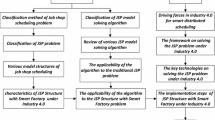Abstract
A GRASP algorithm is presented for solving a sequencing problem in a mixed-model assembly line. The problem is focused on obtaining a manufacturing sequence that completes the greatest possible amount of required work and fulfils the production regularity property. The implemented GRASP algorithm is compared with other resolution procedures by means of instances from a case study linked to the Nissan’s engine plant in Barcelona.
Similar content being viewed by others
References
Battaïa, O., Dolgui, A.: A taxonomy of line balancing problems and their solution approaches. Int. J. Prod. Econ. 142(2), 259–277 (2013)
Boysen, N., Fliedner, M., Scholl, A.: Sequencing mixed-model assembly lines: survey, classification and model critique. Eur. J. Oper. Res. 192(2), 349–373 (2009)
Bautista, J., Cano, A.: Solving mixed model sequencing problem in assembly lines with serial workstations with work overload minimization and interruption rules. Eur. J. Oper. Res. 210, 495–513 (2011)
Yano, C.A., Rachamadugu, R.: Sequencing to minimize work overload in assembly lines with product options. Manag. Sci. 37(5), 572–586 (1991)
Bautista, J., Pereira, J., Adenso-Díaz, B.: A GRASP approach for the extended car sequencing problema. J. Sched. 11(1), 3–16 (2008)
Bautista, J., Cano, A., Alfaro, R., Batalla, C.: Impact of the production mix preservation on the ORV problem. In: Bielza, C., et al. (eds.) CAEPIA 2013, LNAI 8109, pp. 250–259. Springer, Berlin (2013)
Scholl, A., Klein, R., Domschke, W.: Pattern based vocabulary building for effectively sequencing mixed-model assembly lines. J. Heuristics 4(4), 359–381 (1998)
Omar, M., Sarker, R., Othman, W.A.M.: A just-in-time three-level integrated manufacturing system for linearly time-varying demand process. Appl. Math. Model. 37(3), 1275–1281 (2013)
Fullerton, R.R., Kennedy, F.A., Widener, S.K.: Lean manufacturing and firm performance: the incremental contribution of lean management accounting practices. J. Oper. Manag. 32(7–8), 414–428 (2014)
Bautista, J., Cano, A., Alfaro, R.: Modeling and solving a variant of the mixed-model sequencing problem with work overload minimisation and regularity constraints. An application in Nissan’s Barcelona Plant. Expert Syst. Appl. 39, 11001–11010 (2012)
Feo, T.A., Resende, M.G.C.: Greedy randomized adaptive search procedures. J. Global Optim. 6(2), 109–133 (1995)
Resende, M.G.C., Ribeiro, C.C.: Greedy randomized adaptive search procedures: advances, hybridizations, and applications: In: Gendreau, M., Potvin, J.Y (eds.) Handbook of metaheuristics, pp. 283–319. Springer, Berlin (2010)
Acknowledgments
This work was funded by the Ministerio de Economía y Competitividad (Spanish Government) through the FHI-SELM2 (TIN2014-57497-P) project.
Author information
Authors and Affiliations
Corresponding author
Appendix
Appendix
Model for MAX–SAT production mix restriction problem:
Nomenclature:
- I :
-
Set of product types \(\left( {I\,{:}\,i=1,\ldots ,|I|} \right) \)
- \(\vec {d},D\) :
-
Vector of demand \(\vec {d}=(d_{1},\ldots ,d_{|I|})\), and total demand \(D\equiv T=\sum \nolimits _{\forall i} d_i \)
- \(\vec {\lambda }\) :
-
Vector of production mix \(\vec {\lambda }=(\lambda _{1},\ldots ,\lambda _{|I|})\): \(\vec {\lambda }=\vec {d}/D\)
- \(\pi (T)\) :
-
Sequence of products \(\pi (T)=\left( {\pi _1 ,\ldots ,\pi _T } \right) \)
- \(x_{i,t} \) :
-
Binary variable equal to 1 if a product unit \(i\in I\) is assigned to the position \(t \quad \left( {t=1,\ldots ,T} \right) \,\)of the sequence \(\pi (T)\) and to 0 otherwise
- \(X_{i,\,t} \) :
-
Number of units of type \(i\in I\) in the subsequence of products \(\pi (t)\subseteq \pi (T)\). Obviously \(X_{i,\,t} =\sum \nolimits _{\tau =1}^t x_{i,\tau } \quad \forall i\forall t\)
- \(z_{i,t}^+ \) :
-
Binary variable equal to 1 if \(X_{i,\,t} \left( {i\in I,\,t=1,\ldots ,T} \right) \) is greater than the upper limit \(\lfloor \lambda _i t\rfloor \) of production mix preservation and to 0 otherwise
- \(z_{i,t}^- \) :
-
Binary variable equal to 1 if \(X_{i,\,t}\left( i\in I,\,t=1,\ldots ,T \right) \) is less than the lower limit \(\lceil \lambda _i t\rceil \) of production mix preservation and to 0 otherwise
The objective is: \(\lfloor \lambda _i t\rfloor \le X_{i,\,t} \le \lceil \lambda _i t\rceil ,\,\,X_{i,\,T} =d_i \,\,\forall i\in I\,\forall t=1,\ldots ,T\)
MAX–SAT–PMR problem model:
Subject to:
Rights and permissions
About this article
Cite this article
Bautista, J., Alfaro-Pozo, R. & Batalla-García, C. GRASP for sequencing mixed models in an assembly line with work overload, useless time and production regularity. Prog Artif Intell 5, 27–33 (2016). https://doi.org/10.1007/s13748-015-0071-z
Received:
Accepted:
Published:
Issue Date:
DOI: https://doi.org/10.1007/s13748-015-0071-z




